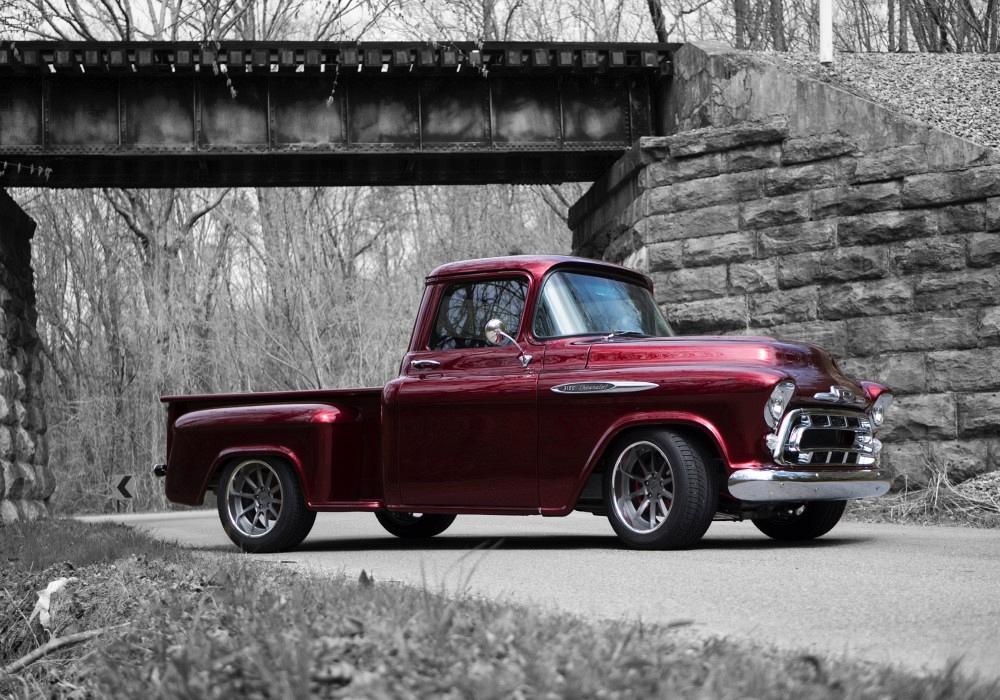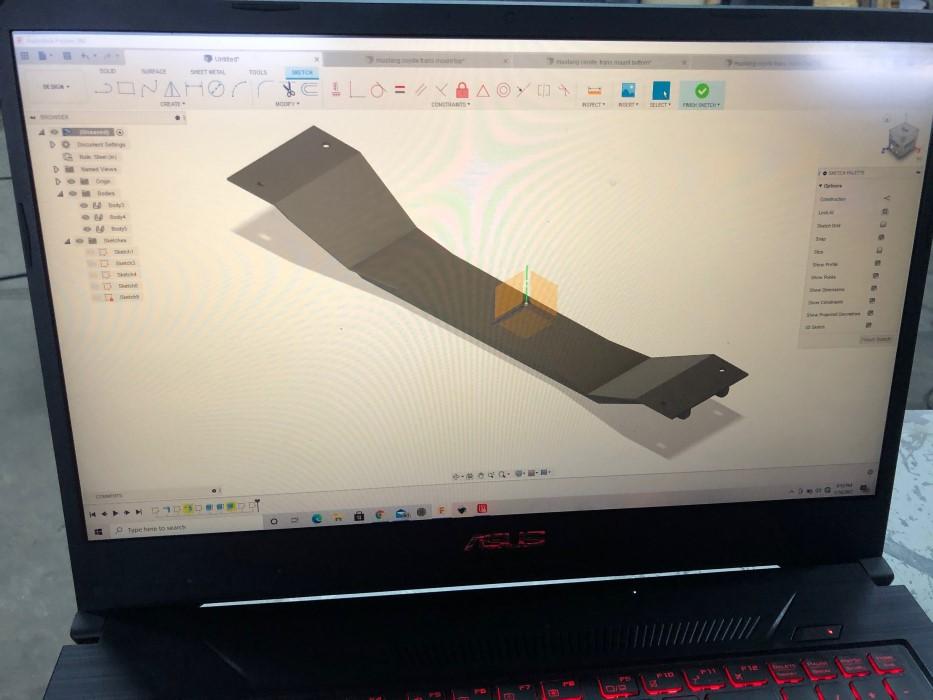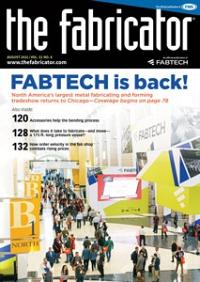- FMA
- The Fabricator
- FABTECH
- Canadian Metalworking
Categories
- Additive Manufacturing
- Aluminum Welding
- Arc Welding
- Assembly and Joining
- Automation and Robotics
- Bending and Forming
- Consumables
- Cutting and Weld Prep
- Electric Vehicles
- En Español
- Finishing
- Hydroforming
- Laser Cutting
- Laser Welding
- Machining
- Manufacturing Software
- Materials Handling
- Metals/Materials
- Oxyfuel Cutting
- Plasma Cutting
- Power Tools
- Punching and Other Holemaking
- Roll Forming
- Safety
- Sawing
- Shearing
- Shop Management
- Testing and Measuring
- Tube and Pipe Fabrication
- Tube and Pipe Production
- Waterjet Cutting
Industry Directory
Webcasts
Podcasts
FAB 40
Advertise
Subscribe
Account Login
Search
Gearhead uses plasma technology, software to restore hot rods, antique cars
Love of automobiles, metal fabricating savvy aided by plasma machine with nesting software
- By Eric Lundin
- August 14, 2021
- Article
- Plasma Cutting

After the requisite schooling and an informal internship with fellow gearhead Bobby Johnson, Wayne McDaniel undertook a frame-off restoration of this 1957 Chevy pickup truck. McDaniel was so sure of the quality of his work that he offered to pay for the materials upfront and the truck owners would reimburse McDaniel only for the work they liked. Images: Wayne McDaniel
Wayne McDaniel has dreamed of owning a hot rod shop for as long as he can remember, and this automotive enthusiast has spent decades methodically inching toward this goal. As time goes on he invests in new tools, accumulates more restoration experience, and expands his reputation as a reliable restorer. With each step, he gets a little closer to going full-time at the business he owns, Elite Restomods, Dallas, Ga.
McDaniel was a “car kid” before he became a “car guy.” His mother recounts stories of him mimicking the sounds coming from the family car’s engine as a toddler buckled into the backseat, and McDaniel spent countless hours trailing his mechanically minded dad as the elder McDaniel tinkered in the garage. He has fond memories of working on his father’s 1977 Dodge Adventurer, a pickup that often carried him to baseball games, band practices, and father-and-son deer hunting trips.
As a teenager, McDaniel purchased a 26-year-old carry-all style truck, a 1976 Dodge Ramcharger, with the cash he saved from years of neighborhood lawn mowing jobs. Charmed by the glitz of professional car ads and looking for another badge on his way to Eagle Scout, he decided to give his Dodge a new coat of paint. Pleased with his color choices—an electric blue for the body and a clean white for the hard top—the teen was somewhat bewildered as to why the Ramchanger did not look brand new when he was done.
“I’m glad it wasn’t a great paint job,” said McDaniel about his first automotive paint job at the age of sixteen. “I might not be working in body repairs if it was awesome on the first go. I desperately wanted to know the secrets to making auto paint look like a professional job.”
A Journey Through Vocational School
This mixture of adolescent disappointment, curiosity, and persistence led McDaniel to study collision repair, autobody refinishing, and automotive fabrication after high school. He trained at Nashville Auto-Diesel College (NADC) in Tennessee (now Lincoln College of Technology).
“I went straight through and I learned a ton,” McDaniel said about his autobody collision and repair program. “Paint is one aspect of restoring older vehicles, but you also need a blend of hands-on skills and artistic talent to repair and restore cars.”
The program prepared him for a career as a collision repair technician and to work in commercial collision centers. He studied refinishing techniques and repaired damaged metal panels using oxyfuel cutting, welding, and body hammers. He learned about feather edging paint and paintless dent repair techniques. He acquired the skills to ramp-up vehicle exteriors using airbrushing techniques, decal applications, and even eye-catching automotive art.
McDaniel loved the hands-on lessons and working on a variety of vehicles in the school’s shop, but the most satisfying project was the 1930 Ford Model A that he helped customize for a family friend. Inspired by “Overhauling,” Chip Foose’s automotive reality television series, McDaniel worked on this car day and night while enrolled in a high-performance fabrication course at NADC. He updated the car’s chassis with a Pete & Jakes brand manufactured frame, replaced the oak floorboards with new custom sheet metal flooring, chopped the car top by 3 in. and used an English wheel to roll the steel roof skin.
On completing the school’s 54-week program, he graduated in the top 10% of his class and received the school’s Craftsman Award for academic excellence in the shop. He wanted to work on hot rods full time after his 2005 graduation, but he took a more pragmatic approach to employment. By starting his career in a collision shop, he earned a dependable salary and gained more hands-on experience in collision repair, autobody refinishing, and automotive fabrication. He worked on wrecks and the routine kinds of repairs associated with insurance claims, but he still daydreamed about designing and building cool cars.

Wayne McDaniel stands next to the 1930 Ford Model A he worked on in Lincoln Tech’s High-Performance Fabrication course.
A Dream Takes Shape
McDaniel eventually took a job at Dallas Collison in Dallas, Ga., and owner Bobby Johnson shared his interest in old school muscle cars and classic trucks. About five years ago McDaniel began heading to Johnson’s home garage in the evenings so they could work on hot rods together. One of the most memorable projects for McDaniel was the complete overhaul and modernization of a 1969 Camaro, which they fitted with a supercharged LS engine and six-speed manual transmission.
“Collision work and hot rods are two separate worlds,” he said. “You wouldn’t work on hot rods during the day because the creative work is slow money. It’s hard to get to the point where you can support 10 or 11 people, so I am extremely grateful for the opportunity [to work with Johnson]. He’s taken me to the next level. He’s taught me a lot and to always see 40 steps ahead. You need to pay attention to the details and think through each design choice. Placement is everything. Where you put the brake master cylinder can later affect a hood hinge. You need to think this all through before you start working.”
McDaniel enjoys working with Johnson, but nothing truly builds self-confidence like finishing a one-off car or truck on your own. McDaniel finally got this opportunity three years ago when he restored a 1957 Chevy truck from bumper to bumper.
“That whole truck was about trust,” McDaniel said. “I asked the owners to give me a chance at every step of that build. I offered to pay for materials and parts upfront, giving the owners the option to only pay for the work if they liked what I did. This allowed me to do things that I haven’t done before. I hadn’t done the headers on the exhaust system before, but that didn’t mean I couldn’t do it. I researched it, watched others online, and I had the fundamental skills and experience to do the job,” said McDaniel. “When I picked a cherry red paint for this truck, the owners couldn’t visualize it, so I did a paint test on the tailgate. Once they saw the color on something larger than a paint sample, they loved it.”
This project was such a confidence booster that McDaniel knew he could have his own hot rod garage.
“When I was done, I thought, ‘Wow, I can really do this,’” he said. “That’s when I registered the Elite Restomods name, got a garage, and started collecting tools.”
One of the tools McDaniel collected is a CNC plasma table. Less than a year ago, he purchased a 4-ft. by 8-ft. PVD multiplatform CNC table built by OEM JD Squared that features a Hypertherm Powermax65 plasma power supply and machine torch. He primarily cuts metal between 10 ga. and 1/2 in. thick with this system.
Cutting with Confidence
JD Squared gave McDaniel a choice of CAD/CAM nesting software with his machine purchase and he picked Hypertherm’s ProNest LT. McDaniel said this software is easy to master.

McDaniel doesn’t take all of the credit for this project, but he certainly created the foundation for a successful result. After he completed the body work, a relative of the car’s owner did the paint work.
“I’m not really computer strong,” he said. “I’m more of a nuts-and-bolts, turning-a-wrench kind of guy, but with ProNest LT, I am extremely happy. I’ve had no problems with the software, and the training videos made everything simple. I just pick the consumables, pick the material, then the thickness, and just hit out-post. It’s really easy, and the cuts are quality on the first try,” explained McDaniel.
The training videos McDaniel referred to are free e-learning resources provided by the manufacturer to help subscribers gain a solid understanding of the software in a short timeframe. McDaniel works long hours, so by the time he gets to his own garage, he already has put in a full day’s work. He wanted training tools that are straightforward, easy to use, and make him money.
“We’ve all seen the trainings that give you the history of the technology,” he said. “I don’t have time for that. Knowing that information will not make me any more money, and it’s boring. I only want the step-by-step process information that I need to run my business. The CAD/CAM Knowledge Base has that. There are a lot of great trainings. Really good, step-by-step, practical trainings.”
Having a CNC plasma in his own garage has given him a new revenue stream and the flexibility to fabricate standard and custom automotive parts. He uses the nesting software to create mounting brackets to secure fuel tanks, electronic control units, and transmission and suspension systems. He cuts frame rails and stiffeners, bumper brackets, and cross members, as well as parts to secure wiring systems, and brake and fuel lines. He sells these parts to other people and uses them in his own projects with Johnson.
“Parts can sometimes be 30 days out for delivery, and those lead times are longer now with the supply-chain issues created by this pandemic,” he said. “The benefit of having the table in my garage is that I can cut parts anytime I want to. I don’t have to wait days and weeks to receive them. Neither do the people that come to me for help,” explained McDaniel. “ProNest LT makes it easier and faster to duplicate parts. I can’t fabricate parts myself as fast or as clean as the CNC plasma.”
McDaniel received a one-year ProNest LT software subscription with his table purchase, and that year is almost up. He plans on paying the monthly subscription fee starting in August.
“It didn’t take me very long to figure out that I will be paying for the software once the trial is up,” he said. “All the cut parameters are already built-in to make it easy. I don’t have to figure everything out. I don’t have to manipulate anything. I don’t have to change the kerf with an offset. It’s all there,” explained McDaniel. “With some other nesting software, you need to build-in those cut parameters yourself with trial and error. Why would anyone want to waste metal if they didn’t have to?”
McDaniel sees the software’s built-in shop reports as key to effectively running his business. He can enter machine and labor production values to automatically calculate part production costs. This helps him price each part and ensure he is profitable.
“Fabricating car parts is helping me get my hot rod shop off the ground. I want to work on hot rods full-time. I’m not there yet, but it will happen.”
About the Author

Eric Lundin
2135 Point Blvd
Elgin, IL 60123
815-227-8262
Eric Lundin worked on The Tube & Pipe Journal from 2000 to 2022.
Related Companies
subscribe now

The Fabricator is North America's leading magazine for the metal forming and fabricating industry. The magazine delivers the news, technical articles, and case histories that enable fabricators to do their jobs more efficiently. The Fabricator has served the industry since 1970.
start your free subscription- Stay connected from anywhere

Easily access valuable industry resources now with full access to the digital edition of The Fabricator.

Easily access valuable industry resources now with full access to the digital edition of The Welder.

Easily access valuable industry resources now with full access to the digital edition of The Tube and Pipe Journal.
- Podcasting
- Podcast:
- The Fabricator Podcast
- Published:
- 04/16/2024
- Running Time:
- 63:29
In this episode of The Fabricator Podcast, Caleb Chamberlain, co-founder and CEO of OSH Cut, discusses his company’s...
- Trending Articles
Tips for creating sheet metal tubes with perforations

JM Steel triples capacity for solar energy projects at Pennsylvania facility

Are two heads better than one in fiber laser cutting?

Supporting the metal fabricating industry through FMA

Omco Solar opens second Alabama manufacturing facility

- Industry Events
16th Annual Safety Conference
- April 30 - May 1, 2024
- Elgin,
Pipe and Tube Conference
- May 21 - 22, 2024
- Omaha, NE
World-Class Roll Forming Workshop
- June 5 - 6, 2024
- Louisville, KY
Advanced Laser Application Workshop
- June 25 - 27, 2024
- Novi, MI



























